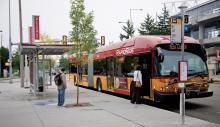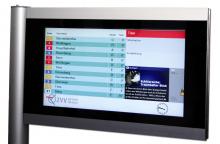David Crawford sees lively prospects for Finnish innovation

Receiving up-to-date passenger information on a journey across Helsinki, courtesy of WSP LIVE
David Crawford sees lively prospects for Finnish innovation
Finland's capital, Helsinki, is set for a great leap forward in its Real-Time Passenger Information (RTPI) and public transport fleet management technology. A new super transport authority currently in the process of being formed will potentially deliver a much larger arena for the deployment of an innovative system that has been in pilot operation in the city since 2007.By end-2008, Helsinki City Transport (HKL) had already initiated a tendering process for a major expansion, by 2011 to all its buses, of the piloted
The tendering process has, however, recently come under review in the context of ongoing plans for a merger between HKL and the
Merger proposals
These have recently become the subject of proposals for a political merger into a single metropolitan authority, accentuating the relevance of a single regional public transport administration. YTV also maintains regional databases and carries out research on regional issues, including transport.In the light of its findings, it had already developed its own project for building an RTPI network array covering the whole of the Helsinki metropolitan area. The HKL expansion plans would have overlapped with this, and logic indicated a rephasing.
A new tender process is, therefore, now due to start later in 2009, with YTV's object being to roll out the resulting RTPI and traffic signal priority solution across all bus routes in the region within a single year. Meanwhile, the WSP LIVE pilot will keep running and providing growing levels of practical experience for the benefit of the new project.
The technical specifications for this have yet to be finalised, apart from requirements for the system architecture to be server-based and for the delivery of increased vehicle positioning accuracy. "However", says HKL planner Arttu Kuukankorpi, "if all goes well with the project that we are now working on, we expect it to be the basis for the new information service. WSP LIVE has proved to be an extremely cost-effective platform for gathering, utilising and distributing real-time public transport information for both large and small vehicle fleets."
Internet assistance
The system has emerged from a 2007 joint research project between HKL and WSP, which has over 20 years' experience of working in the public transport sector in Finland. HKL have funded it as a means of exploring the possibilities of using mobile broadband for public transport information and management applications. One of HKL's aims is to ensure help from the internet on every journey.Kuukankorpi: "Our primary objective in terms of bus traffic is to implement traffic signal priority. We have learned from the pilot that, in addition to the GPS signal, we also need to use odometer data from the vehicle to make positioning sufficiently accurate enough for giving priority; so that will be a requirement in the tender" Adds Mika Varjola, WSP Finland's Head of Unit, Transport Information Systems: "This emphasis reflects the fact that signal priority makes services faster and better at time-keeping, and so delivers fuel and time savings for both the operator and the city. At the same time, passenger information increases user satisfaction, and this can mean increased revenue as patronage increases. So both aspects can have financial benefits."
The pilot began with six trams, and 24 buses running on six routes. The operator of three of these changed at the beginning of 2009, resulting in the onboard equipment being transferred to a seventh route.
Tracking solution
WSP LIVE works by tracking vehicles using a combination of advanced high-accuracy GPS and mobile broadband. It updates the tracking once a second for each vehicle in a fleet, transmitting its new location once a second to the system server. This stores the resulting data on all vehicle movements for later viewing in detail for fleet management, safety or security needs.WSP has designed the architecture to set very low requirements for the vehicles' onboard computers, to enable cost-effective installation on large fleets. At the management level, WSP LIVE allows HKL to react fast to changing situations. It can, for example, create or modify signal priorities on a Web interface, by dragging a new request to a location and then releasing it to become effective immediately.
The system uses advanced statistical methods constantly to calculate next bus or tram arrival time forecasts for individual stops. It is designed to draw on past and present events with relevant levels of emphasis to generate reliable information that will rapidly adapt to changing circumstances.
It then presents the forecasts by means of its LIVE Info and LIVE Control applications on multiple platforms for viewing by both passengers in transit and operators. The operator can set LIVE Control automatically to compare actual movements against schedules routes and deliver information on late or early departures or arrivals, or route gaps.
The same technology can be used to create passenger information displays in public areas, simply by plugging in an internet-capable computer. This has not yet happened although WSP has carried out a pilot with wireless at-stop information screens based on FM broadcasts.
New metropolitan area solution
WSP LIVE is thus a strong candidate for the new metropolitan area-wide solution. It would replace the existing HeLMi ITS system for public transport, launched in 1999 jointly by HKL and the Traffic Planning Division of the City of Helsinki.At the time, while similar systems were in use in several European cities, HeLMi attracted attention as one of the most sophisticated, being based almost solely on wireless communication using radio modems. In its lifetime, it has played a major role in increasing bus usage. "But," says Kuukankorpi, "while it might have been sophisticated in 1999, 10 years is a long time in the IT industry and now both HKL and YTV are looking for a new-generation solution."
One of its key elements will be a common information centre, covering the whole of the Helsinki metropolitan region and equipped to deliver a more comprehensive version of the current HeLMi public transport disruption notification service. This alerts travellers to delays of more than 15 minutes on trams, the metro, some commuter rail links and the ferry service to the island of Suomenlinna, a Helsinki suburb and tourist destination.
HKL
HKL is responsible for providing local public transport within Helsinki, delivering 221 million passenger journeys a year on 500 buses, 90 trams and 45 metro trains. Bus services are competitively tendered, with five companies currently operating them.Carrying some 200,000 passengers every weekday, trams have established themselves as the main form of public transport within the inner city; 11 routes operate over 71km of track and there are current plans for future extensions.
The 21km-long metro carries some 60 million passengers a year between 17 stations. Despite its relatively small size, as compared with the systems of other capital cities, it has become a defining symbol of the city, transporting passengers from one end to the other in 20 minutes. Quality surveys have rated passenger satisfaction at high levels in terms of both smoothness of ride and schedule keeping.
It is, therefore, not a high priority for equipping with WSP LIVE, except to the extent of giving passengers a future additional incentive. The subject may, however, acquire added relevance in the context of planned extensions across the Helsinki metropolitan area.
HKL began installing a mobile broadband network based on Flash-OFDM technology in its vehicles in 2007. It joined WSP in the current pilot as a way of testing the connection as a general communication channel for all vehicle data transmission purposes.
For passengers the biggest benefit of the network connection in buses is the faster travelling times resulting from the traffic signal priority for connected vehicles.
The WLAN connection in the buses and trams offers the passengers updated in-trip public transport information as well as free Internet access. Real-time public transport information is available on the start page when the passenger opens the Internet browser.
Future planned enhancements could include building a traffic information system for the benefit of drivers and a camera surveillance network for the safety of both drivers and passengers. Both, says Varjola, could be installed very rapidly.








